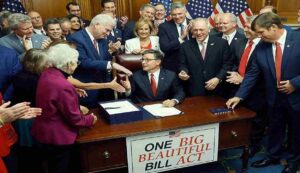President Donald Trump’s tax-cut bill passes its final hurdle in the US Congress
WASHINGTON: The Republican-controlled House of Representatives narrowly approved a massive package on Thursday that would fund President Donald Trump‘s domestic agenda and force millions of Americans to forgo health insurance, clearing the last hurdle in the U.S. Congress for his tax cuts and new legislation.

The Republican president will use the 218-214 vote to finance his immigration crackdown, extend the tax cuts he made in 2017, and implement fresh tax advantages he pledged to do during his 2024 campaign.
Additionally, it eliminates hundreds of renewable energy subsidies and slashes health and food safety net programs. The impartial Congressional Budget Office estimates that it would increase the country’s debt by $3.4 trillion to $36.2 trillion.
After an overnight stalemate, just two of the 220 Republicans in the House ultimately voted against the 869-page plan, despite worries within Trump’s party about its cost and potential impact on healthcare services. The Senate, which is controlled by Republicans, has already passed the measure by the smallest possible margin.
Trump will sign it into law on Friday, July 4, Independence Day, at 5 p.m. ET (2100 GMT), according to the White House.
Republicans claimed that the bill would boost economic development and reduce taxes for Americans of all income levels.
“This is jet fuel for the economy, and all boats are going to rise,” State Representative Mike Johnson said.
All of the Democrats in Congress opposed the plan, calling it a gift to the rich that would deprive millions of people of health insurance.
House Democratic Leader Hakeem Jeffries gave the longest speech in the history of the chamber, lasting eight hours and forty-six minutes. “The focus of this bill, the justification for all of the cuts that will hurt everyday Americans, is to provide massive tax breaks for billionaires,” Jeffries said.
Throughout, Trump persisted in pressuring legislators to complete the task by threatening them and offering incentives.
“It should be an easy yes vote for Republicans. He posted, “RIDICULOUS!!!” on social media.
Only two House Republicans actually voted against the package, despite the fact that over a dozen threatened to do so: Thomas Massie of Kentucky, a conservative who said the bill did not slash spending enough, and Brian Fitzpatrick of Pennsylvania, a moderate.
MARATHON WEEKEND
Republicans worked through the weekend and had all-night discussions in the House and the Senate in a desperate attempt to fulfill Trump’s deadline of July 4. Vice President JD Vance provided the tiebreaking vote in Tuesday’s 51-50 Senate vote, which saw the measure pass.
The CBO estimates that the plan would reduce expenditure by $1.1 trillion and tax collections by $4.5 trillion over a ten-year period.
Medicaid, which covers 71 million low-income Americans, is mostly responsible for such budget reduction. The CBO estimates that the measure would leave about 12 million people without health insurance because it would tighten enrollment requirements, impose a work requirement, and crack down on a financing mechanism that states use to increase federal payments.
To allay fears that such cuts would drive rural health providers out of business, Republicans allocated $50 billion for them.
The richest Americans would profit the most from the measure, according to nonpartisan researchers, while those with lower incomes would essentially experience a decline in their earnings because the safety-net cutbacks would exceed the tax savings.
According to economists, the bill’s higher debt burden would also essentially shift funds from younger to older generations. Due to the growing debt, ratings agency Moody’s downgraded U.S. debt in May. Additionally, some overseas investors claim that the law is devaluing U.S. Treasury bonds.
By raising the US debt limit by $5 trillion, the law eliminates the possibility of a short-term default. However, some investors are concerned that the debt overhang may limit the bill’s economic boost and raise the possibility of higher borrowing prices in the future.
Conversely, the plan prevents tax hikes that would have affected the majority of Americans at the end of this year, when Trump’s 2017 tax cuts for individuals and businesses were set to expire. In addition to expanding tax incentives for firms and parents, those savings are now permanent.
In keeping with Trump’s campaign pledges, the plan also creates additional tax advantages for seniors, car loans, overtime compensation, and tips.
Compared to the first version of the measure that was approved by the House in May, the final version of the package features more severe healthcare cutbacks and more significant tax cuts.
Republicans also eliminated a “retaliatory tax” on foreign investment that had raised concerns on Wall Street and a measure that would have prohibited state-level artificial intelligence laws during Senate debates.
When Democrats aim to retake at least one house of Congress in the 2026 midterm elections, the bill is probably going to be a major topic. Many of the bill’s benefit cutbacks aren’t expected to take effect until after that election, and Republican leaders argue that the tax incentives would boost the economy before then. Many Americans are worried about the bill’s cost and how it would affect those with lower incomes, according to opinion surveys.